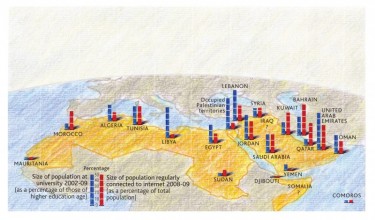Amidst the ongoing debate of the role of social media in revolutions across the Middle East and North Africa lies another question: To what degree does Internet access matter in determining the role of the Internet and social media in these revolts? In Egypt and Tunisia, many attribute an important role to online tools while others debate their worth; most observers fall somewhere in the middle,, recognizing the value of the Internet but remaining realistic about its limitations.
On my own blog, I framed the question slightly differently, asking::
The normative question in relation to the Internet (mobile is obviously a different story) is, then, how much do basic indicators like Internet and mobile penetration affect the effectiveness of such tools for organizational or revolutionary purposes? Or, can a tiny group of Internet users influence a countrywide movement?
But in comparing the role of the Internet in Egypt (where most accounts* put Internet penetration between 20-25%) and Tunisia (which hovers closer to 35%) to the potential role of the Internet in other countries, one must take into consideration the access in that country. In Libya, for example, access to the Internet is only available to about 5% of the population. Statistics on individual social media sites are also important when analyzing their role in a protest movement. CNN has an excellent map of Facebook and Internet penetration in the Middle East and North Africa

Blogger Andrew Trench recently presented a theory on the threshold of when Internet penetration starts to matter, writing::
Social networks have also been given plenty of credit for the revolution unfolding in Egypt.
So I went and had a look at the numbers over on www.internetworldstats.com to see what they could tell us about these two scenarios. Well, fascinatingly, both Egypt and Tunisia have seen a massive growth in internet users and internet penetration over the last 10 years.
Both have now got internet penetration of over 20% and in Tunisia’s case it was as high as 34%.
While it is clearly simplistic to over-state this factor and there must be many more drivers contributing to such a rapid political uprising, it is obviously a factor as evidenced by the Egyptian regime pulling the plug on the country’s internet access to try and block the rising tide of revolt.
My back-of-napkin theory is this: that a rapid increase in internet penetration in a repressive regime does play an important role as it provides an unfettered channel of communication allowing disaffected citizens to share views – and more importantly – to rapidly organise and mobilise.
If Egypt and Tunisia are valid case studies, it looks like internet penetration of around 20% is the mark”.
Geopolitics & Macroeconomics adds :
Internet penetration: Social networking sites were critical to sustaining the momentum in the recent protests. The internet penetration in Egypt is 16%. In Libya, it is a meagre 5% [1]. The unrest in Libya has thus far remained concentrated in regions that are geographically distant from the seat of ‘real’ power (see more on this below). The dependence of momentum on internet communication is far greater in Libya than in Egypt where protests began in Cairo itself.
Taking the conversation to Pakistan, Sabene Saigol writes, on blog BrandRepublic :
” Perhaps one reason for this is that we’re still not that used to communicating via the ‘net – maybe we need greater broadband and internet penetration. Personally I think it is more to do with culture – while Pakistani internet users are savvy to using social media to connect with friends, I feel they have not yet ‘crossed over’ to seeing SM as a means for professional communications – or even wider social communications that go beyond their immediate circle. Yes, there are no doubt savvy people – both within marketing and tech circles, and outside – however, these people are likely a tiny proportion of the total number of ‘net and social media users.”.

The role of mobile receives perhaps even less media attention than the role of other technologies. And yet, mobile penetration is higher across the region than Internet, with only Yemen, the occupied Palestinian territories, and Syria reporting fewer than 50% mobile subscribers. Several countries in the Middle East and North Africa, including Saudi Arabia, Oman, and the UAE, boasted mobile subscriber rates of over 100%.. MobileActivehas detailed mobile data by country.
Micah Sifry, writing for TechPresident, has also considered mobile, arguing: :
” The biggest factor in the unfolding events, to me, appears to be the emergent power of young people, compounded by how urbanized they are and how connected they are by mobile phones.
If you look at the available data on degree of internet penetration, number of mobile cellular subscriptions per 100 people, percentage of population under the age of 15 and degree of urbanization, what jumps out is how the last three factors seem to matter more.”.

Sifryadds:
With the exception of Yemen, mobile coverage in the other five countries I’ve focused on–Egypt, Tunisia, Syria, Jordan and Iran–hovers between 98% and 100%.
Finally, the pace of mobile phone penetration has exploded, far faster than internet penetration. With the exception of Jordan, which boasted a 23% mobile phone subscription rate in 2002, in the other five countries mobile ownership was in the single digits–just six percent in Egypt and Tunisia back then. That has skyrocketed in 2007 to 76% in Tunisia and 40% in Egypt, according to MobileActive.org.
Could it be that what we’re witnessing is the political coming of age of Generation TXT?
*For those interested in learning more about Internet penetration globally, there are two main organizations which track such data: the l’Union internationale des Télécommunications and the Banque mondiale. heir statistics sometimes differ. The website Internet Internet World Stats aggregates their data, as well as the data from smaller or more localized institutions.




